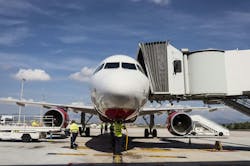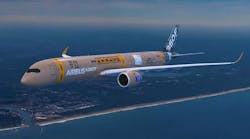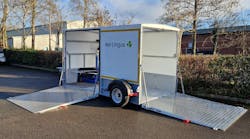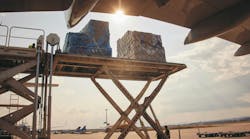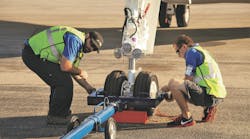Throughout the world, companies are employing ESG strategies to enhance their businesses.
Originally used as a philosophy for finance and investing, ESG – or environmental, social and governance – initiatives have expanded into a structure that evaluates a company’s business practices.
Among other goals, ESG programs aim to enhance sustainability practices, create positive working environments with employees, customers and communities, and guide corporate governance procedures.
With lofty environmental targets on the horizon and safety as a top priority, the aviation industry – including the ground support equipment and ground handling markets – is taking action to employ ESG programs in various ways.
SAF’s Role in Green Aviation
A key environmental initiative in aviation is decarbonizing operations. Neste, a producer of sustainable fuels and renewable feedstock solutions, has embarked on decarbonization efforts in three specific areas.
Through various initiatives, Neste is working to increase the availability and accessibility of sustainable aviation fuel (SAF); offer solutions like renewable diesel fuel for ground support equipment (GSE) and other ground handling operations; and assist in the recycling of waste materials to create more sustainable fuels.
Neste has been producing SAF since 2011 when hydroprocessed esters and fatty acids (HEFA-SAF) received approval for use as jet fuel.
“We are now serving more than 70 direct customers across the aviation supply chain and in 21 countries. Neste is increasing its SAF production capability as we speak,” points out Carrie Song, commercial operations lead of Neste’s renewable product business. “Today, Neste has an annual SAF production capability of 365 million gallons of SAF and will support market demand with 515 million gallons of SAF later this year.”
Renewable diesel, made from 100-percent renewable raw materials like used cooking oil or animal fat, can decarbonize ground operations and be used to fuel GSE, ground transportation vehicles and other equipment at airports.
“In the U.S., Neste collects used cooking oil from over 80,000 locations via our subsidiaries. This is then converted into renewable fuel at one of Neste’s refineries, which our customers use to reduce their greenhouse gas (GHG) emissions,” Song says. “We are committed to helping our customers reduce their GHG emissions by 20 million tons per year by 2030. In 2022, our products helped customers reduce over 11.1 million tons of GHG emissions.”
New low- and zero-emission technologies make it possible to accelerate the transition to a sustainable, low carbon transportation system, according to Song. Solutions like vehicle electrification, renewable fuels and hydrogen cells also are emerging, and Song says all solutions are needed to help transition away from fossil fuels quicker.
“The simple truth is that there is no silver bullet for kicking the fossil fuel habit, because what works for one type of transportation will not work for another,” Song says. “Aircraft shrink the world so we can get from point A to point B in hours instead of days but depend on fossil jet fuel. Neste believes there are actions we can take now to make transportation more sustainable, so we developed solutions like renewable diesel and sustainable aviation fuel to help industry partners take action today.”
However, a lack of awareness, limited access and availability, and insufficient government policy support has hindered the adoption of renewable fuels.
“Renewable diesel and SAF were not really well-known when they were first introduced to the market. So Neste continues working hard on explaining and demonstrating their benefits to customers, industry experts, government officials and the general public to enable them to become the customer’s choice,” Song says.
Policies like Europe’s ReFuelEU regulation and the Renewable Fuels Standard (RFS) in the U.S. have spurred production. However, even with IATA’s projection of 8 billion gallons of annual SAF production by 2030, SAF will only equal 10 percent of total jet fuel demand. That’s up from 0.1 percent today, but is still not enough to meet the industry’s goal of net-zero emissions by 2050, Song warns.
“Neste has an annual SAF production capability of 365 million gallons of SAF and will support market demand with 515 million gallons of SAF later this year. Ongoing investments will further increase our SAF production capability to 750 million gallons (2.2 million tons) in 2026,” Song says.
“We also work hard with infrastructure owners to ensure our renewable fuels can be easily transported using existing (gray) infrastructure,” Song continues. “A most recent example is that we partnered with Vopak, an international energy infrastructure company, to convert 22 of their tanks in Los Angeles that used to store fossil fuels into storage facilities that will be used to store Neste’s renewable fuels. Altogether, the combined capacity of these tanks reach 39 million U.S. gallons. This means better availability and quicker accessibility of SAF for airlines at LAX and surrounding airports using existing infrastructures.”
Neste officials say they will continue to ramp up production of renewable diesel and SAF to support their customers' ESG goals.
They will also focus on developing new raw material sources, so in the future, renewable products can be made from forestry and harvesting waste (also known as lignocellulosic waste), municipal solid waste and algae, and by using new technologies like e-fuels.
“At the moment, 40 percent of the motorized equipment at the airport runs on electricity. And that number will increase over the coming years. However, for a number of specialist heavy vehicles, it is a technical challenge to develop a battery with sufficient capacity that can also be charged quickly enough. Using Neste MY Renewable Diesel is therefore a good solution currently,” says Paul Feldbrugge, who is responsible for the Zero Emission Program within KLM Equipment Services.
“The use of renewable fuel is another important building block and a very important addition to our concept for climate-friendly mobility,” adds Thilo Schmid, CEO of Cologne Bonn Airport GmbH. “For some vehicles, diesel propulsion is still the necessary standard, e.g. for the very large and heavy vehicles used by the airport’s fire department. For these, Neste MY Renewable Diesel is a solution enabling immediate decarbonization.”
Song says renewable solutions are key levers in helping hard-to-abate sectors reduce reliance on fossil fuels and greenhouse gas emissions.
While more stakeholders are contributing to the development of renewable fuels and solutions, Song says it is important to take climate action immediately.
“Climate change is the No. 1 pressing issue our society is facing. It is changing the way we live and how we do business,” Song says. “To thrive tomorrow, businesses need to transform and operate in a more sustainable way today, and this is also what customers, investors, employees and the general public expects.”
Digitalization’s Environmental and Personnel Benefits
In an effort to uphold its own standards for customer service, company officials with ground service provider Acciona identified its manual processes for resource utilization were no longer adequate.
As a provider of ramp and cargo services and passenger handling in Europe and the Americas, using manual processes for day-to-day operations like comparing planned staff resources versus used resources; generating staff rosters; checking the status of flights; contacting airfield operators; and retrieving historical data was time-consuming and challenging.
Acciona, with environmental benefits and personnel efficiencies in mind, set out to digitalize its resource allocation processes.
“Using INFORM’s GroundStar Software Suite, Acciona has been able to optimize the utilization of its resources, which has helped them achieve resource optimization goals – part of their ESG initiatives,” explain company officials at INFORM. “GroundStar helped them achieve improved planning, faster rescheduling and efficient resource and task allocation. In addition to attaining ESG results, GroundStar helped them achieve a digital transformation.
“In addition, since ground handling safety events can have serious and expensive consequences, involving injuries and even deaths, causing operational delays as well as damage to aircraft and equipment, it was key to have GroundStar in place to help ensure that ground operation activities were always to be performed safely,” INFORM officials continue.
Acciona first implemented the GroundStar Software Suite at Santiago de Chile Airport and successfully digitalized operational processes for planning and managing both staff and GSE. The software has allowed for improved resource usage and productivity, fleet reduction and the identification of potential disturbances.
“Acciona has benefited not only in the digitalization area, but has also contributed to improving resource usage, a key ESG goal,” INFORM officials note. “Potential disturbances can now be identified in advance, giving room to look for a better response plan.
“Additionally, due to the multi-station feature of GroundStar Software Suite, Acciona was able to extend its network in Chile to 14 airports in record time by modeling the existing implementation in Santiago.”
Applying optimization algorithms, Acciona managers create automatically optimal staff shift demands and GSE requirements for day-of operations. These tasks are performed seamlessly, even if flights schedules are disrupted.
“GroundStar also generates optimized ground handling and passenger services staff rosters that were made available on a staff portal for easy access by employees using their mobile devices,” INFORM officials say.
Given the scale of Acciona’s digital transformation and ESG goals, one challenge that had to be overcome was helping ground staff become comfortable with the new technologies. Demonstrating use cases at other locations helped motivate Acciona personnel to adopt the solution.
For example, replacing manual Microsoft Excel spreadsheet processes and voice/radio communications benefited the company and its employees.
“Staff efficiency has been significantly enhanced because they can now be notified of important status updates such as receiving confirmations on the beginning or ending of tasks. They can retrieve information to support operations and/or to analyze a station’s performance once the operation is completed,” INFORM officials explain. “All of these capabilities help Acciona achieve great optimization and better performance, which greatly supports ESG initiatives.”
eGSE Investments to Hit ESG Goals
As a company that has been producing electric-powered lifts since the 1960s, officials at Lift-A-Loft understand the importance of minimizing their company’s carbon footprint.
As such, Lift-A-Loft has begun investing in new battery technology and utilizing electric chassis.
“As our GSE sector has continued to grow, we have begun adapting our APX series to run and drive on lithium batteries,” says Braedon Stark-Abbott, sales associate at Lift-A-Loft. “We also have begun design work and are now offering our truck-mounted TL scissor, which is traditionally on a gas chassis on a Ford etransit.”
As the GSE industry – and other markets around the world – shift to using more sustainable energy, Stark-Abbott says Lift-A-Loft found it necessary to be part of this change.
“Airports are under constant pressure to reduce their pollutants and an easy start is by electrifying GSE,” he says.
Since the start of 2023, Lift-A-Loft has delivered more than 30 of its electric APX series lifts to airline customers, with more scheduled to be deployed soon. Stark-Abbott says staying in direct communication with customers has helped overcome challenges and has allowed for a successful roll out.
“For our APX, as a relatively small company, the strain was mostly on the design team,” Stark-Abbott says. “Deciding what batteries would be best suited for all climates, deciding the chassis for our APX to maximize the battery life while also considering the need for a durable chassis that can withstand the beatings of the tarmac.
“Another challenge is cost and availability of electric chassis with enough payload for a scissor lift for our non-APX units.”
By offering both the APX medium duty lift and TL22 truck-mounted unit on electric chassis, officials at Lift-A-Loft hope more companies will consider converting their equipment to electric. Having electric units available has allowed Lift-A-Loft to supply its equipment in areas that require clean energy products such as California, Stark-Abbott notes.
According to Lift-A-Loft officials, feedback on electric chassis lifts has been favorable.
“As these units are a newer product for us, we keep an open line of communication with our customers and have service people on standby to help fix any issue that could arise,” Stark-Abbott says, noting the company intends to expand its eGSE offerings.
“We plan on being able to offer our heavy-duty 32-foot maintenance lift on an electric chassis in the near future as well.”
Sustainable Sources for GSE Products
Combining safety with brand recognition is a valuable strategy for businesses involved in transportation and logistics – as well as any industry that requires safety regulations like ground handling, advises Nick Tykoski, CEO at Safety Decals.
To improve the safety of ground handlers working on the ramp while keeping environmental impact at a minimum, Safety Decals embarked on a partnership with Orafol Americas to create custom Department of Transportation (DOT) conspicuity tape to achieve this goal.
“We have effectively developed custom DOT conspicuity tape that has been granted approval by the DOT,” Tykoski says. “This enhances the visibility and safety importance of both our company and our customers’ businesses.”
Working with Orafol was an important component of this project. In addition to complying with safety regulations, Orafol takes key steps to protect the environment during the manufacturing process.
Orafol’s company headquarters has a customized environmental management system certified to ISO 14001 standards. Regenerative incinerators are used to reduce emissions from manufacturing processes and improve air quality.
Energy efficiency is maximized by returning the recovered heat to the production process and the heating system, creating a closed raw material, energy and resource cycle, according to Orafol officials. What’s more, in-house environmental lakes are designed to minimize the environmental impacts of production and protect the health of employees and the surrounding community.
While Safety Decals’ mission to responsibly source and develop DOT-certified tape for ground support equipment applications succeeded, challenges were met along the way. Tykoski notes that finalizing the CMYK colors in accordance with industry standards while maintaining the integrity of the reflective material proved difficult.
With that challenge solved, Tykoski reports feedback has been positive.
“It was a fulfilling journey with numerous adjustments, but the effort was absolutely worthwhile," Tykoski says.
